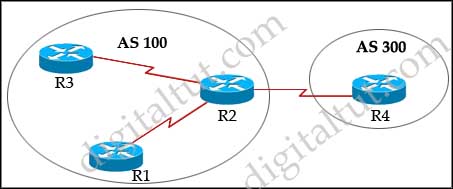BGP Questions 6
Here you will find answers to BGP questions – Part 6
Question 1
Which attribute must exist in the BGP update packet?
A. LOCAL, PREF
B. AGGREGATOR
C. AS_Path
D. Weight
Answer: C
Explanation
Origin, AS_Path, Next_Hop are well-known mandatory BGP attributes that all BGP Updates must include.
Note:
There are 4 BGP attribute types:
+ Well-known Mandatory: recognized by all implementations of BGP and must appear in a BGP update message. If missing, a notification error will be generated.
+ Well-Known Discretionary: recognized by all implementations of BGP but may not be sent in the BGP update message (include LOCAL_PREF, ATOMIC_AGGREGATOR).
+ Optional Transitive: may or may not be recognized by all BGP implementations. Because the attribute is transitive, BGP accepts and advertises the attribute even if it is not recognized (include Community attribte).
+ Optional Nontransitive: may or may not be recognized by all BGP implementations. Whether or not the receiving BGP router recognizes the attribute, it is nontransitive and is not passed along to other BGP peers (include MED).
Question 2
To enable BGP tunneling over an IPv4 backbone, the IPv4 address 192.168.30.1 is converted into a valid IPv6 address. Which three IPv6 addresses are acceptable formats for the IPv4 address? (Choose three)
A. 192.168.30.1:0:0:0:0:0:0
B. 0:0:0:0:0:0:192.168.30.1
C. ::192.168.30.1
D. C0A8:1E01::
E. 192.168.30.1::
F. ::C0A8:1E01
Answer: B C F
Question 3
A problem was reported that the 10.10.10.0/24 prefix was not injected into the local BGP table on RouterA. The following information is available from RouterA. Why is this prefix not in the local BGP table?
| configuration: router bgp 65001 network 10.0.0.0 neighbor 172.16.1.1 remote-as 65002 no auto-summary routing table information show ip route | include 10 O 10.10.10.0/24 [110/11] via 192.168.1.1, 2d00h, Ethernet0/0 |
A. This route is not a BGP learned route.
B. The network command is wrong.
C. The 172.16.1.1 neighbor is down.
D. The prefix 10.10.10.0/24 is not ‘connected’ route.
Answer: B
Explanation
The correct network statement should be “network 10.0.0.0 255.255.255.0”. BGP will not advertise a prefix unless the prefix is also already installed in the routing table. Here the prefix installed in the routing table is “O 10.10.10.0/24”, but network command is 10.0.0.0 without a subnet mask. Therefore, the BGP process will use the default classful subnet mask of /8 and will not advertise it because it cannot find an exact prefix match in the routing table also. (Thanks dj for your explanation)
Question 4
Refer to the exhibit. All routers are configured for BGP. EBGP routes received on router R2 show up in the BGP table on routers R1 and R3 but not in their IP routing table. What would cause this? (Choose two)

A. Synchronization in autonomous system 100 is turned is on.
B. Synchronization in autonomous system 100 is turned is off.
C. EBGP multihop is not configured on routers R1 and R3.
D. Routers R1 and R3 do not receive the same routes via an IGP.
E. The BGP routers in autonomous system 100 are not logically fully-meshed.
Answer: A D
Explanation
The synchronization rule states BGP should not advertise a route until all of the routers within the AS have learned about the route via an IGP so in this case if R1 and R3 have not learned that route via IGP, they cannot appear in their routing tables.
Question 5
Based on the R3 show ip bgp output, which statement is true?

A. The best path to reach the 192.168.11.0 prefix is via 10.200.200.11.
B. The best path to reach the 192.168.11.0 prefix is via 10.200.200.12.
C. The best path to reach the 192.168.11.0 prefix is via both 10.200.200.11 and 10.200.200.12; BGP will automatically load balance between the two.
D. The 192.168.11.0 and 192.168.12.0 prefixes were learned via EBGP from the 10.200.200.11 and 10.200.200.12 EBGP neighbors.
Answer: B



b i t . l y / 2 R O t k M W Cisco Routing and Switching foundation learning guide cover the entire course included in CCNA ICND1 and ICND2 exams.